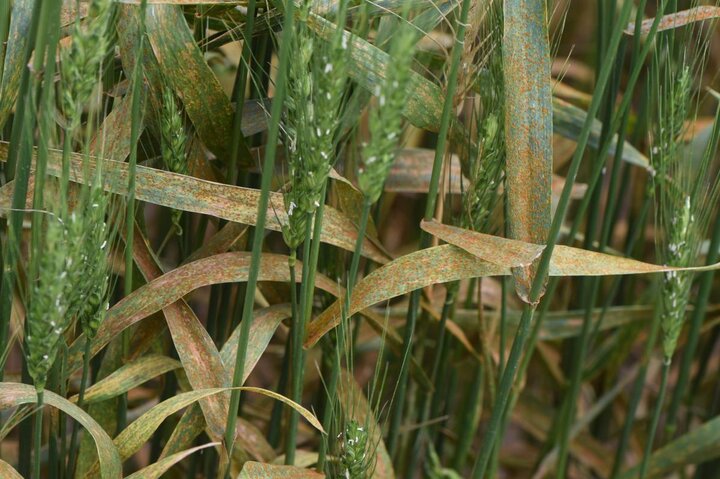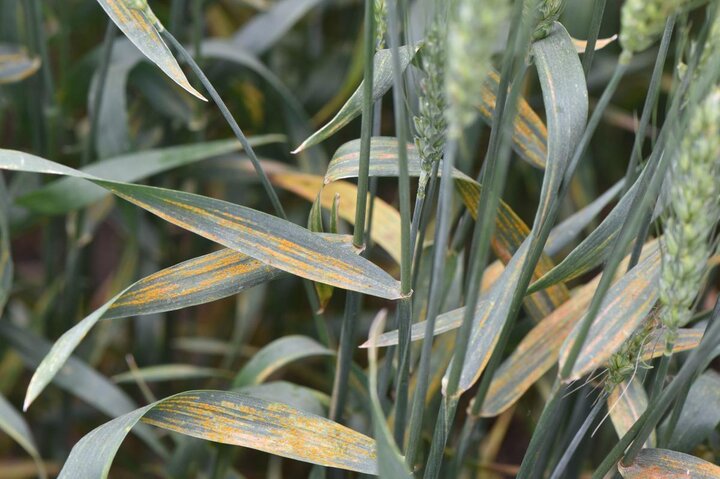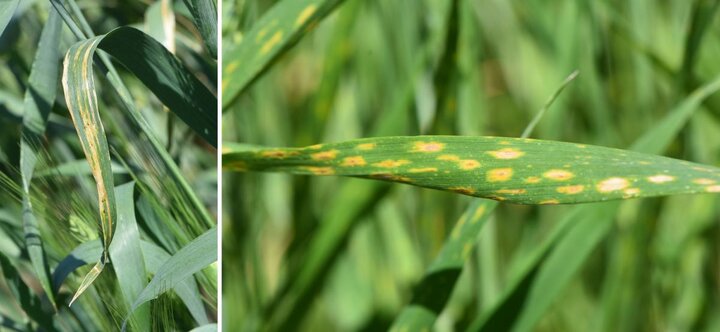
Surveys conducted June 16-20 in all wheat growing regions in the state showed diseases were increasing due to favorable wet conditions. There was a sharp contrast between the southeast where diseases were conspicuous (Figure 1) and the northern Panhandle where fields looked lush green (Figure 2). Wheat in the southeast was in the advanced stages of development (soft dough, Feekes 11.2) whereas growth stages in the west ranged from heading and flowering (Feekes 10.5) in the northern Panhandle to milk (Feekes 11.1) in the southwest.


On June 16 in Jefferson County, there were moderate to high levels of Fusarium head blight (FHB, scab) in a state variety trial and in a grower’s field (Figure 1). On June 17 in a state variety trial at the Eastern Nebraska Research and Extension Center near Mead in Saunders County, the predominant diseases were FHB at moderate to high levels and leaf rust that was very severe on susceptible varieties (Figure 3). In the same trial there were hot spots of stripe rust in a few varieties (Figure 4). In research plots at Havelock Research Farm near Lincoln (Lancaster County) on June 18, there were moderate to high levels of FHB and leaf rust was severe on susceptible varieties.

At the West Central Research and Extension Center near North Platte (Lincoln County) on June 18, FHB was just starting to develop (Figure 5). On June 19 at the Henry J. Stumpf International Wheat Center near Grant (Perkins County), there were moderate levels of Septoria tritici blotch (Figure 6) in research plots and severe levels of Cephalosporium stripe (Figure 7) in susceptible lines in a breeding nursery. Fusarium head blight was just starting to develop at the Center and was confirmed in a grower’s field not far from the Center.

In Deuel County on June 19, growers’ fields along Highway 30 looked lush green on the top of the canopy with low to moderate levels of fungal leaf spots in the lower canopy. In a grower’s field and at the High Plains Ag Lab (HPAL) near Sidney (Cheyenne County) on June 20, the predominant disease was bacterial streak (Figure 8). Trace levels of stripe rust, FHB, and wheat streak mosaic were also observed in a breeding nursery at HPAL. In a grower’s field in Box Butte County on June 20, trace levels of stripe rust and moderate to high levels of tan spot in its initial stages of development (Figure 9) were observed.
Management
The majority of wheat fields in the east, central, and southwest are past the stage when a fungicide can be applied. In the Panhandle, fields that are at the heading to flowering growth stage can be sprayed with a fungicide to suppress FHB and control foliar fungal diseases (rusts and leaf spots). Fungicides that are effective on FHB, such as Prosaro, Caramba, or Miravice Ace, are recommended. Although FHB generally does not occur in the Panhandle due to drier weather, this year is different in that there has been plenty of rainfall before and during flowering, which has increased the risk of FHB.
Bacterial streak, wheat streak mosaic, and Cephalosporium stripe cannot be controlled once they occur.
